Yesterday morning I had another supremely challenging session with the nest-building waxwings in the Wasatch Mountains.
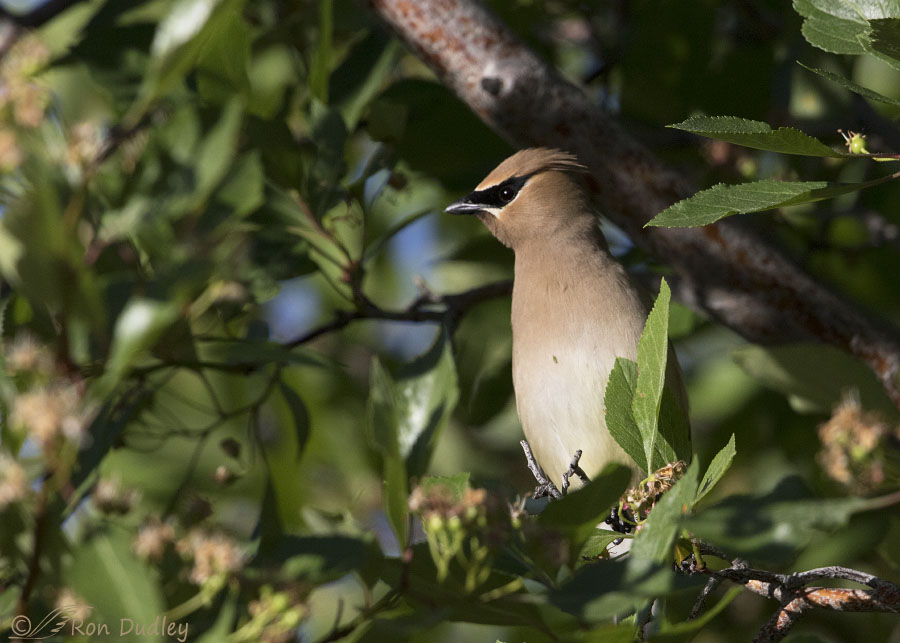
1/5000, f/6.3, ISO 800, Canon 7D Mark II, Canon EF 500mm f/4L IS II USM + EF 1.4 III Extender, not baited, set up or called in
The nest they continue to build is deeply buried in this hawthorn tree – so effectively hidden that it took me two days to finally see part of it, even though I knew exactly where it was (I could sometimes see partial birds moving around in it). The living part of the tree is so dense (there are dead parts too) that I was usually lucky to see even this much of a bird while they were perched in its vicinity. When they would bring in nesting material they nearly always took a straight shot into the nest and didn’t pause for a portrait.
They worked on the nest for the entire time I was there but reasonable shooting opportunities were slim to almost nonexistent. These photos were the best I could do.
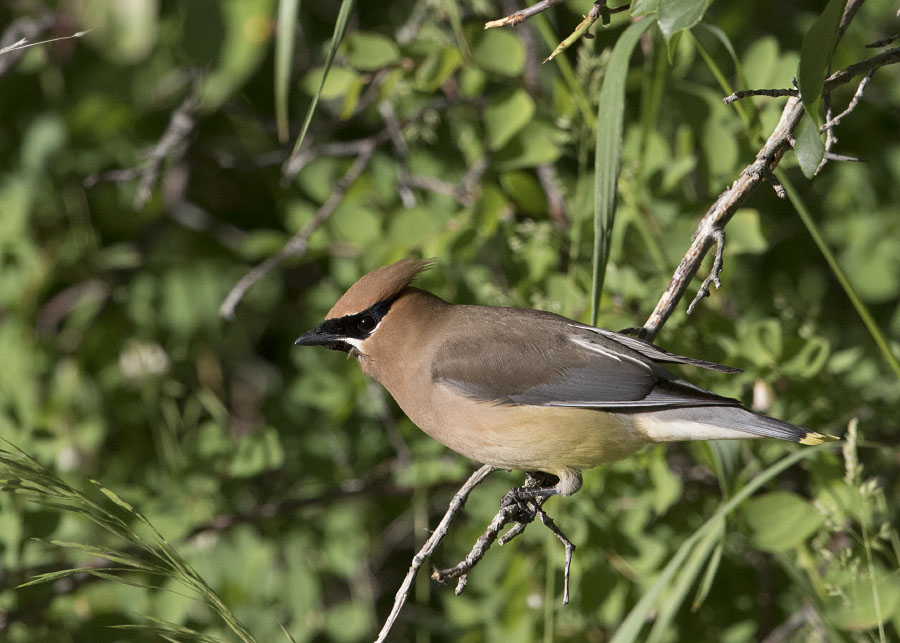
1/3200, f/6.3, ISO 800, Canon 7D Mark II, Canon EF 500mm f/4L IS II USM + EF 1.4 III Extender, not baited, set up or called in
Very rarely one came out into the open for a few seconds.
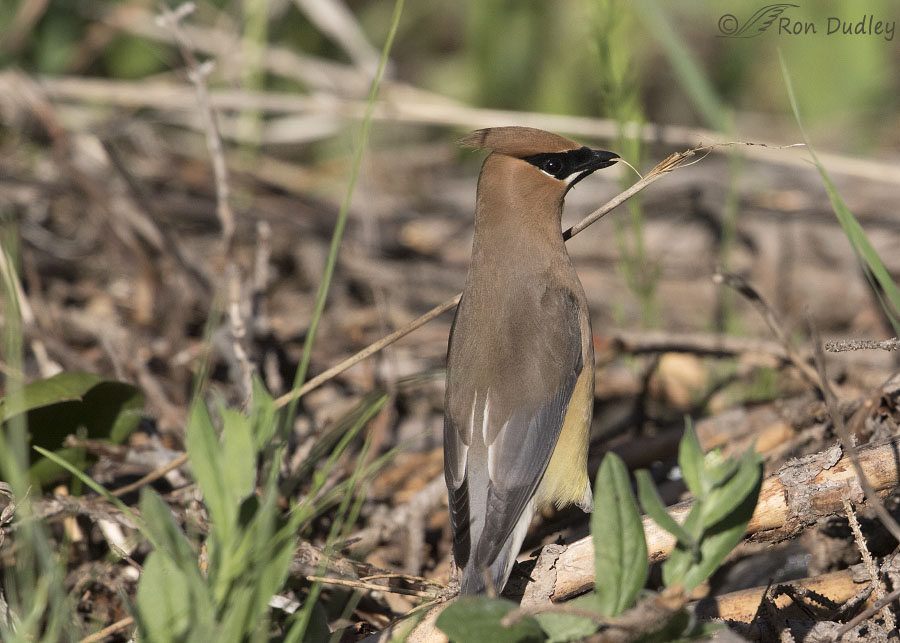
1/5000, f/6.3, ISO 800, Canon 7D Mark II, Canon EF 500mm f/4L IS II USM + EF 1.4 III Extender, not baited, set up or called in
Usually they came out of the nest like a shot and flew far away to gather the next load for the nest but twice one of them looked for nesting material on the ground where I could see it. Here the bird picked up this long twig (I’ve cropped the photo so we can see all of it) but eventually it was rejected.
At this point they were lining the nest cup with softer grasses and they weren’t really interested in coarser materials like twigs and small sticks.
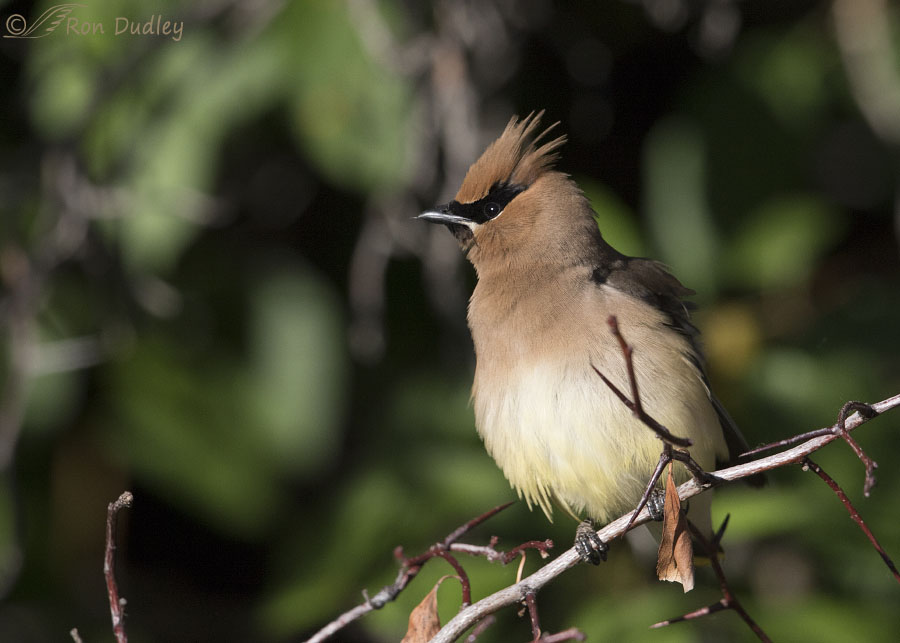
1/3200, f/6.3, ISO 800, Canon 7D Mark II, Canon EF 500mm f/4L IS II USM + EF 1.4 III Extender, not baited, set up or called in
I caught this bird rousing. Normally I reject photos with annoying shadows on the bird but with these waxwings photographic success is relative…
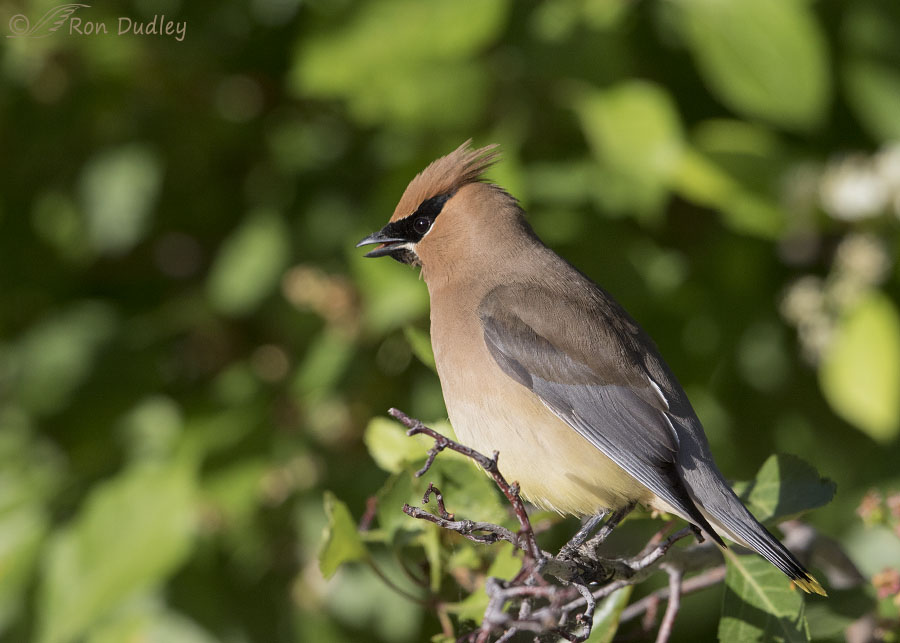
1/2000, f/6.3, ISO 800, Canon 7D Mark II, Canon EF 500mm f/4L IS II USM + EF 1.4 III Extender, not baited, set up or called in
This one was probably calling but I don’t remember hearing it at the time. Their calls are soft and difficult for me to hear. Interestingly, Cedar Waxwings do not sing, they only call.
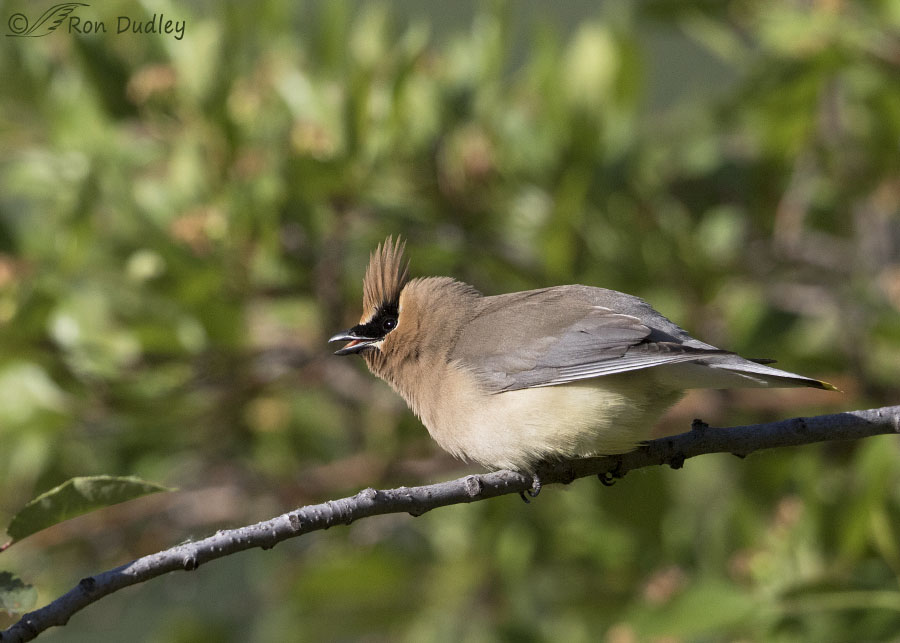
1/4000, f/6.3, ISO 800, Canon 7D Mark II, Canon EF 500mm f/4L IS II USM + EF 1.4 III Extender, not baited, set up or called in
This one looks like it’s calling but it isn’t. Just prior to this shot it was cleaning its bill on the perch and it opened its bill and raised its crest when it finished.
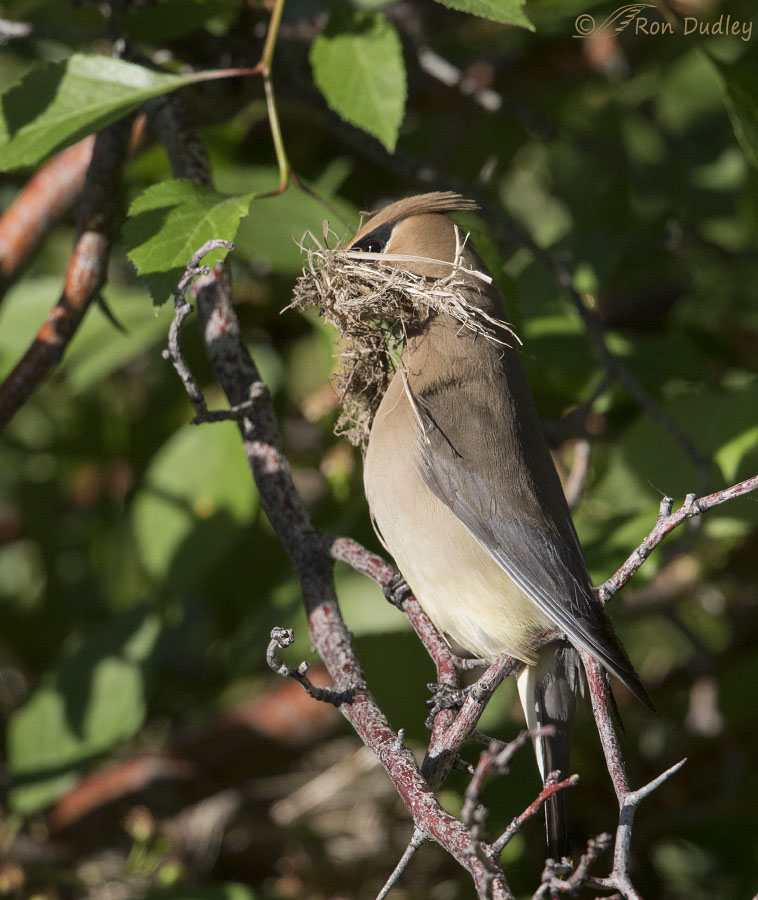
1/2000, f/6.3, ISO 800, Canon 7D Mark II, Canon EF 500mm f/4L IS II USM + EF 1.4 III Extender, not baited, set up or called in
This is one of the very few times a bird didn’t fly directly into the nest with its load. They would often carry massive amounts of soft grasses and sometimes there was so much of it that in flight parts of the load trailed behind the end of their tail.
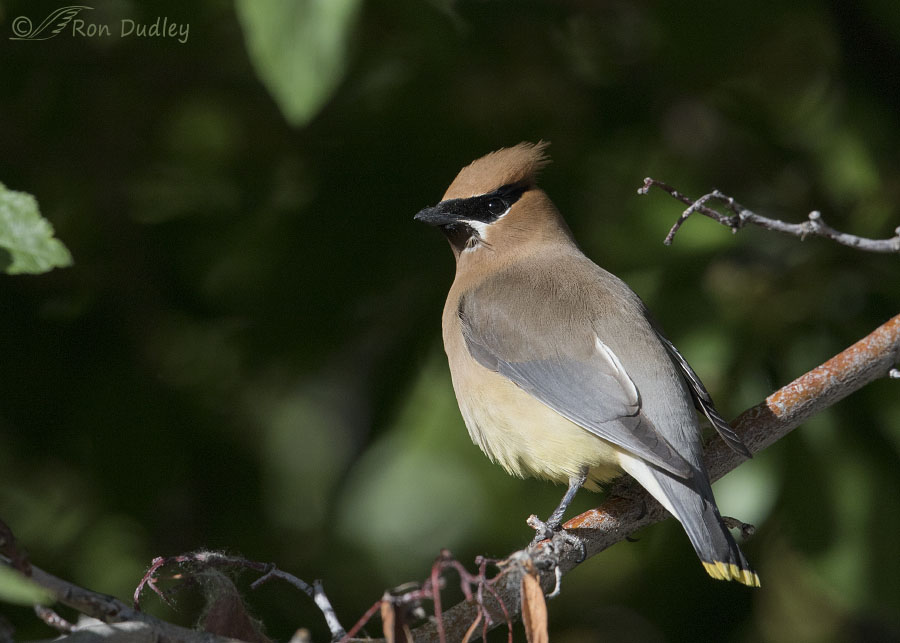
1/2000, f/6.3, ISO 800, Canon 7D Mark II, Canon EF 500mm f/4L IS II USM + EF 1.4 III Extender, not baited, set up or called in
This was as close as I ever came to getting a clean shot of a waxwing yesterday. I like the well-lit bird against the very dark background even though it was a tricky exposure and I had to bring down some of the brights during processing.
It goes without saying that I never approached the nest or got out of my pickup while photographing these birds. They’re acclimated to humans and their contraptions in the area and they continued to build their nest for the entire time I was there. One of the advantages of a long lens is not needing to get close to our subjects, especially while they’re nesting.
Ron
Note to photographers: This series illustrates why I often use shutter speeds that seem excessive for the situation. Notice that my SS varied wildly, from 1/2000 to 1/5000 second. That’s because I shoot in aperture priority, lighting was extremely variable and one of my goals was flight/takeoff shots that require fast SS’s to get the wings sharp. If I took the time to change my settings for different lighting situations I’d often miss the shot completely.
And no, I never did get any decent flight shots…


Truly amazing!
Lovely shots!
It is soooo good to start my day (after rebooting the rotten machine three times) with awe, with wonder and with joy.
Megathanks.
Good! Thank you, EC.
I envy you the opportunity to watch Cedar Waxwings, even though the photos weren’t portrait quality (in your eyes). All of these shots are ones I would be thrilled to get – of any bird… 🙂
Thank you, Susan.
Lovely as usual. Waxwings are so smooth in their coloration, it is hard to see definition in the feathers. When in hand they are a very soft, satin feeling bird. My husband can not hear the calls either, I make him nuts when I say, “waxwing can you hear it?” Bohemian’s have a slightly lower trill, can you hear them? I like the dark background and the contrast it creates too. I often try for the contrast. It can be challenging not to blow out the whites. Some friends have asked me is I change the light in processing. No I don’t. I look for morning light highlighting the intended subject with a shaded backdrop.
Mia does the same thing – she hears them and I don’t. And I have good hearing. I haven’t spent enough time around Bohemians to know (or remember) if I hear them or not.
Thank you for your sticktoitiveness, Ron. These shots are a real treat! Even though I know the shots difficult to get, I really appreciate seeing these birds surrounded by all the lush greenery. I especially like the “post-bill-cleaning” one — looks like she’s all proud of herself and her clean beak.
*shots ARE difficult to get
I can just hear Truman Capote as Lionel Twain yelling at me! 😉
Yoda was quietly applauding though.
Geez, MARTY – you’re allowed the occasional typo ya know. Thank you.
As you know I have felt for some time that you should write a photographic illustrated book on bird behavior from a teacher/bird photographers point of view. These as well as many other of your great bird and behavior shots should become a reference for Ornithologists and birders. What a great piece of work that would be!
Great shots, super job under difficult situations.
Thanks for the encouragement, Dick. I appreciate it.
FABULOUS idea! I’ll second the motion! 😀
Cedar waxwings are near the top of my favorites list–actually they share the top with several other birds, but hey! I’m easily amused. Anyway, they’re just so darn gorgeous. What amazed me when the whole flock showed up at my Dallas home to strip all the berries off the laurel trees is that yellow at the end of their tail and on their wingtips looks like they’ve been dipped in high-gloss acrylic paint! The texture and look of the feather is completely different from the rest of their feathers. It’s shiny and looks thicker than the rest of the feather. Absolutely gorgeous!
BTW, I planted several other laurel trees for their migratory dining pleasure!
Sorry I’ve been gone for a while. My computer continues to act up and with each passing update, it gets worse. I’m very close to using the hammer option!
Thanks, Laura. I wondered if you were still having troubles…
Splendid series of photos of these beauties Ron. I really like the one with the nesting material in its bill.
The Cedar Waxwing is very interesting to me, and a bird I have little experience with. I have seen them only a few times in Northern New Mexico.
It is interesting to me that build their nests so late in the year. Your post has motivated me to learn more, and I will read through the Cornell BNA online articles on them.
It feels great here today in Santa Fe, low temps, very high humidity and light showers. Supposed to rain all weekend. I hope you get some nice moisture too from these hurricane remnants.
Yes, they’re known as late nesters, Ed.
Good for your rain! In NM you’re in for a very scary fire season this year.
Ron,
Beautiful pics. Thanks for your efforts. I was also wondering about your metering. I’ll watch for your response to Frank. Are you up one of the canyons?
Stephen
Thanks, Stephen. Yes, I’m in a canyon – at my age I’m not much of a mountain climber… 🙂
Hi Ron. Love Waxwings. They have always been one of my favorites since I was a kid. I wonder how they got the name Waxwing. Maybe I’ll google it and see what I can find. Appreciate your comments about exposure and camera operating techniques. I shoot manual, which I have mentioned before. The argument I use for making that decision is that for the most part, I try to only shoot when birds with the sun at my back and only when the bird is illuminated, not in the shade. As such, the light on the subject is constant and there is no need to change my settings. I want the proper exposure on the subject and the background doesn’t matter. Any least that’s the theory and I’m sticking too it. However……. in your case, your shutter speeds varies almost two stops,I assume because of the changing backgrounds, but the light on the bird is constant. But what I don’t get is why the exposure on the bird seems to remain good, unless you have adjusted the exposure in post. So that would lead me to the conclusion you are using a very small (spot) metering technique. Is that true? My problem is that I am so stuck on manual that I never vary. Perhaps because I simply to not understand the auto exposure techniques. Sorry for the blathering. Just trying to improve my understanding of auto vs. manual. Appreciate your patience. Have a wonderful day!
Frank, the name waxwing came from the red waxy-looking ends of some of their flight feathers that many waxwings have but that trait is highly variable and I don’t really see it in these photos. You can see those red waxy spots in the last shot in this post:
https://www.featheredphotography.com/blog/2018/06/12/cedar-waxwings/
I do some exposure adjustment in post if necessary but I also adjust my exposure in the field in camera by changing my E.V. I’ve set my camera for 1/3 stop increments – most of these shots were taken at -1/3.
Beautiful! 🙂 🙂 🙂 They are illusive for sure in summer…….;) Only summer time good look/shots I ever got was when a flock was cleaning the blossoms off an apple tree. They blend in amazingly well. That’s quite a mouth full of nesting materials!
I’m always a little surprised by how cryptic they are, Judy. You’d think they’d be easier to see in their habitat. Thanks.
Your patience is inspiring.
Bird photographers have to be stubborn and persevere, Pam. It’s a good thing I have patience in the photography arena because I’m sure lacking it in other aspects of my life…
Wonderful behavioral sites of one of my favorite birds Ron!
Charlotte
Thank you, Charlotte.